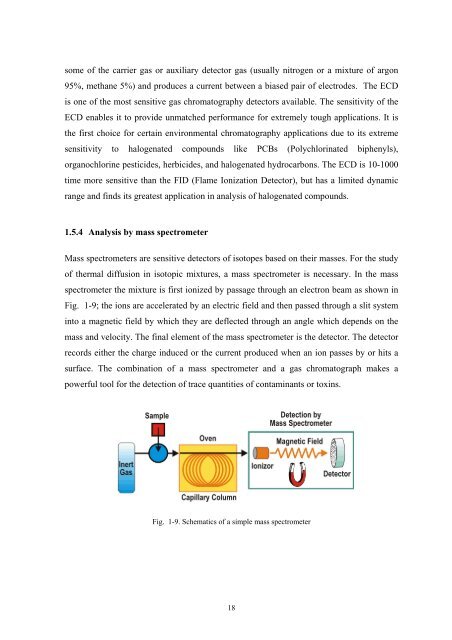r - Les thèses en ligne de l'INP - Institut National Polytechnique de ...
r - Les thèses en ligne de l'INP - Institut National Polytechnique de ...
r - Les thèses en ligne de l'INP - Institut National Polytechnique de ...
Create successful ePaper yourself
Turn your PDF publications into a flip-book with our unique Google optimized e-Paper software.
some of the carrier gas or auxiliary <strong>de</strong>tector gas (usually nitrog<strong>en</strong> or a mixture of argon<br />
95%, methane 5%) and produces a curr<strong>en</strong>t betwe<strong>en</strong> a biased pair of electro<strong>de</strong>s. The ECD<br />
is one of the most s<strong>en</strong>sitive gas chromatography <strong>de</strong>tectors available. The s<strong>en</strong>sitivity of the<br />
ECD <strong>en</strong>ables it to provi<strong>de</strong> unmatched performance for extremely tough applications. It is<br />
the first choice for certain <strong>en</strong>vironm<strong>en</strong>tal chromatography applications due to its extreme<br />
s<strong>en</strong>sitivity to halog<strong>en</strong>ated compounds like PCBs (Polychlorinated biph<strong>en</strong>yls),<br />
organochlorine pestici<strong>de</strong>s, herbici<strong>de</strong>s, and halog<strong>en</strong>ated hydrocarbons. The ECD is 10-1000<br />
time more s<strong>en</strong>sitive than the FID (Flame Ionization Detector), but has a limited dynamic<br />
range and finds its greatest application in analysis of halog<strong>en</strong>ated compounds.<br />
1.5.4 Analysis by mass spectrometer<br />
Mass spectrometers are s<strong>en</strong>sitive <strong>de</strong>tectors of isotopes based on their masses. For the study<br />
of thermal diffusion in isotopic mixtures, a mass spectrometer is necessary. In the mass<br />
spectrometer the mixture is first ionized by passage through an electron beam as shown in<br />
Fig. 1-9; the ions are accelerated by an electric field and th<strong>en</strong> passed through a slit system<br />
into a magnetic field by which they are <strong>de</strong>flected through an angle which <strong>de</strong>p<strong>en</strong>ds on the<br />
mass and velocity. The final elem<strong>en</strong>t of the mass spectrometer is the <strong>de</strong>tector. The <strong>de</strong>tector<br />
records either the charge induced or the curr<strong>en</strong>t produced wh<strong>en</strong> an ion passes by or hits a<br />
surface. The combination of a mass spectrometer and a gas chromatograph makes a<br />
powerful tool for the <strong>de</strong>tection of trace quantities of contaminants or toxins.<br />
Fig. 1-9. Schematics of a simple mass spectrometer<br />
18

















